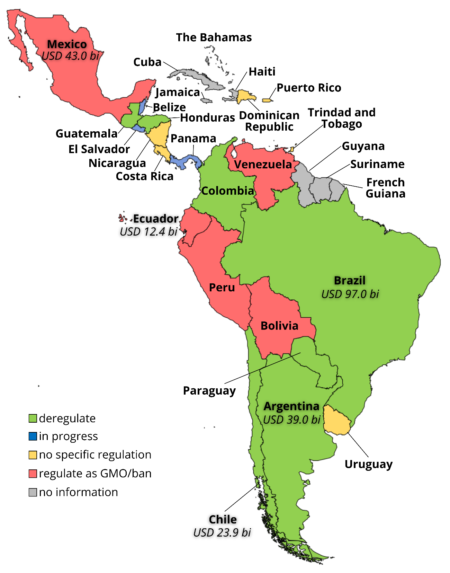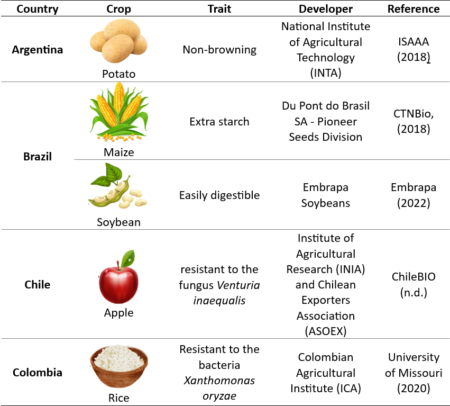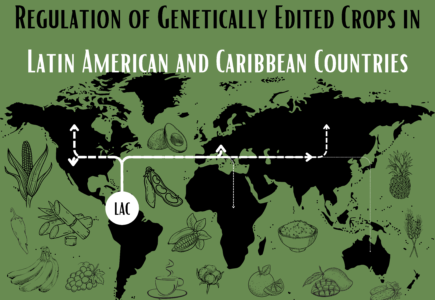Article and cover figure by Luiza Favarato Santos
According to the United Nations (2019), the world population is expected to reach 9.7 billion by 2050. Approximately 2.3 billion people globally live in moderate and severe food insecurity (World Hunger Clock, 2023). In order to reduce food insecurity, production must increase, but this needs to be done while also ensuring the achievement of the United Nation’s Sustainable Development Goals (SDGs). The agricultural sector is an important contributor to the release of greenhouse gases into the atmosphere (UNF 2021), with particular emphasis on methane and nitrous oxide (SEEG 2023), but it also leads in the sequestration of carbon through crop production.
The Latin America and Caribbean (LAC) region spans over 2 billion hectares, allocating 38% of land to agriculture (FAO, 2023a), a sector vital to the economies of many LAC nations. This diversity-rich region showcases both large-scale and export-oriented farms in the Southern Cone, mainly in Argentina and Brazil, with millions of smallholder and family farms contributing significantly to food production. With abundant land and water resources, the LAC region is responsible for 45% of global yield production of primary crops (FAO, 2023b) and 25% of exports in these commodities (FAO, 2023a).
Precision Breeding
In a world struggling with increasing population and climate change challenges, gene editing (GEd) technology stands out as a transformative technology poised to revolutionize agriculture. Unlike conventional breeding methods that are time-consuming and often imprecise, gene editing techniques allow scientists to make targeted modifications to an organism’s DNA with remarkable accuracy. This precision enables the development of crops with desirable traits such as increased yield, enhanced nutritional content, resistance to pests and diseases, and adaptability to environmental conditions. Furthermore, GEd presents a pathway to crop diversification and increased resilience. By expanding the range of crops available for cultivation, gene-edited varieties can reduce the risk associated with monoculture farming and enhance agricultural resilience against disease outbreaks (Fernandes et al., 2022).
The path of genetically edited organisms from the lab to the market is marked by intricate regulations that differ globally. Precision breeding, referred to as “new breeding technologies (NBT)” presents challenges for biosafety regulators due to the evolving legal definitions of gene-edited organisms according to domestic biosafety laws.
Status of Gene Editing Regulations
 Figure 1 LAC countries regulation on GEd organisms and the top five exporters of food. Green: considered as conventional crop if does not have an exogenous gene; Blue: still analyzing how they will regulate GEd organisms; Yellow: no specific regulation on GEd organisms, usually working on a case-by-case basis; Red: regulate every GEd organism as GMO or ban their use; Grey: no information found in the government website or no biosafety laws enacted. (Adapted and modified from source)
Figure 1 LAC countries regulation on GEd organisms and the top five exporters of food. Green: considered as conventional crop if does not have an exogenous gene; Blue: still analyzing how they will regulate GEd organisms; Yellow: no specific regulation on GEd organisms, usually working on a case-by-case basis; Red: regulate every GEd organism as GMO or ban their use; Grey: no information found in the government website or no biosafety laws enacted. (Adapted and modified from source)
In the complex landscape of gene editing regulations, the LAC region showcases diverse approaches in the regulation of genetically edited organisms (Figure 1). In a collective declaration to the World Trade Organization, nations including Argentina, Brazil, the Dominican Republic, Guatemala, Honduras, Paraguay, and Uruguay aligned with the USA, Canada, and Australia to advocate for risk appropriate regulatory frameworks concerning genome editing. Honduras and Guatemala have recently approved the use of GEds. Even though Chile and Colombia did not participate, they regulate gene-edited crops that do not contain foreign DNA as conventional plants. These nations aim to strike a balance between promoting innovation, ensuring biosafety, and fostering international trade. Argentina, Brazil, Chile, and Colombia have already released GEd crops in the market (Table 1).

Table links: ISAAA (2018), CTNBio (2018), Embrapa (2022), ChileBIO (n.d.), University of Missouri (2020)
Conversely, nations like Bolivia, Ecuador, Mexico, Venezuela, and Peru have chosen a more cautious approach by placing restrictions on GEd crops, either considering it a genetically modified organism or banning production in the country. Meanwhile, Uruguay, Costa Rica, Nicaragua, Dominican Republic, and Puerto Rico have no specific legislation on GEd, working on a case-by-case basis. Other countries like Panama, El Salvador and Belize are still debating their regulatory framework regarding GEd organisms (Figure 1).
These variations underscore the necessity for international collaboration and dialogue to formulate cohesive and effective regulatory frameworks. Such frameworks can catalyze innovation, support trade, and enable sustainable agricultural growth, ultimately contributing to the prosperity of the Latin America and Caribbean region and the world.
Benefits to the LAC Regions
GEd crops hold the potential to significantly lower production costs, reduce pesticide use, conserve biodiversity, bolster climate resilience, and minimize food loss and waste. The resultant increase in food availability and affordability can be transformational, particularly for vulnerable populations in the LAC region, where 26.1 million people subsist on less than US$1.90 per day (World Bank, 2019). GEd technology can also be used to create crops with enhanced nutritional value, making them more nourishing for LAC consumers.
An additional benefit beyond cost savings for farmers is that the diminished use of pesticides yields vital environmental benefits by decreasing chemical runoff and reducing soil and water contamination. Apart from that, GEd technology offers smallholder and family farms an opportunity to combat devastating crop pests that possess the potential to devastate entire harvests, while also mitigating the adverse effects of volatile international prices.
These advancements hold the promise of endowing the LAC region with heightened competitiveness in international agricultural markets, as they facilitate the production of premium-quality crops at more competitive price points. Consequently, GEd crops can act as a potent catalyst for driving economic growth, alleviating poverty, and elevating living standards throughout the LAC region.
For more information about the regulation on GEd crops in Latin American countries, see:
Chapter 10 “Regulation of CRISPR Edited Plants in Latin America” from book “Global Regulatory Outlook for CRISPRized Plants” by Fernandes PMB, Favaratto L, Merchan-Gaitan J et al (2023). Elsevier, 1st Ed. ISBN 9780443184444. Editors: Kamel A Abd-Elsalam, Aftab Ahmad. Available at: <https://shop.elsevier.com/books/global-regulatory-outlook-for-crisprized-plants/a-abd-elsalam/978-0-443-18444-4>.
References
Alcántara JA (2019) INFORME N.° 00310-2019-MINAM/VMDERN/DGDB/DRGB. Minist. del Ambient. Viceministerio Desarro. Estratégico los Recur. Nat. Dir. Gen. Divers. Biológica 1–21. Available from: <https://bioseguridad.minam.gob.pe/wp-content/uploads/2020/04/vigilancia_piura_maiz2019.pdf>.
CTNBio (2018) PARECER TÉCNICO 6208/2018. Available from: <https://ctnbio.mctic.gov.br/documents/566529/2298305/Parecer+6208-2018+-+milho+ceroso/f646d200-83ed-46b3-ba90-b727202cbd9e?version=1.1>.
ChileBIO (n.d.) Cultivos editados genéticamente “made in Chile”: manzanas, lechugas y cerezos. Available from: <https://www.chilebio.cl/2019/05/23/cultivos-editados-geneticamente-made-in-chile-manzanas-lechugas-y-cerezos/>.
El Peruano (2020) El Peruano – Ley que modifica la Ley 29811, Ley que establece la moratoria al ingreso y producción de organismos vivos al territorio nacional por un período de 15 años, a fin de establecer la moratoria hasta el 31 de diciembre de 2035 – LEY – N° 31111 – P. Available from: <https://busquedas.elperuano.pe/normaslegales/ley-que-modifica-la-ley-29811-ley-que-establece-la-moratori-ley-n-31111-1917468-1/>.
Embrapa (2022) Gene-edited to reduce anti-nutritional factors, soybeans get green light. Available from: <https://www.embrapa.br/en/busca-de-noticias/-/noticia/73468020/ctnbio-aprova-soja-da-embrapa-com-genoma-editado-para-reduzir-fatores-antinutricionais>.
FAO (2023a) Agricultural Outlook 2023-2032. Available from: <https://www.agri-outlook.org/documents/Regional_LatinAmerica&Car.pdf>.
FAO (2023b) Crops and livestock products. Available from: <https://www.fao.org/faostat/en/#data/QCL>.
Fernandes PMB, Favaratto L, Fernandes AAR, et al. (2022) To become more sustainable organic agriculture needs genome editing technology. Front. Bioeng. Biotechnol. 10:912793. Available from: <https://www.frontiersin.org/articles/10.3389/fbioe.2022.912793/full>.
Fernandes PMB, Favaratto L, Merchan-Gaitan J et al. (2023) Regulation of CRISPR Edited Plants in Latin America in “Global Regulatory Outlook for CRISPRized Plants”. Elsevier, 1st Ed. ISBN 9780443184444. Available from: <https://shop.elsevier.com/books/global-regulatory-outlook-for-crisprized-plants/a-abd-elsalam/978-0-443-18444-4>.
Garcia Ruiz MT, Knapp AN, Garcia-Ruiz H (2018) Profile of genetically modified plants authorized in Mexico. GM Crop. Food 9, 152–168. Available from: <https://pubmed.ncbi.nlm.nih.gov/30388927/>.
Genetic Literacy Project (GLP) (2020) Global Gene Editing Regulation Tracker and Index. Available from: <https://crispr-gene-editing-regs-tracker.geneticliteracyproject.org/>.
Gobierno de México (2021) Permisos de 2005 a 2021. Available from: <https://conacyt.mx/cibiogem/index.php/permisos-2005-2021>.
Gobierno del Ecuador (2023) AGROLOCALIDAD. Available from: <https://www.agrocalidad.gob.ec/la-institucion/>.
Instituto Nacional de Tecnología Agropecuaria (INTA), 2020. El INTA siembra las primeras papas que no se oxidan. Estac. Exp. Agropecu. Balcarce. Available from: <https://www.argentina.gob.ar/noticias/el-inta-siembra-las-primeras-papas-que-no-se-oxidan>.
ISAAA (2018) Argentine Scientists Develop Non-Browning Potatoes Using CRISPR Available from: <https://www.isaaa.org/kc/cropbiotechupdate/article/default.asp?ID=16472#:~:text=Argentine%20Scientists%20Develop%20Non%2DBrowning%20Potatoes%20Using%20CRISPR,-May%2023%2C%202018&text=Researchers%20from%20the%20Instituto%20Nacional,that%20causes%20browning%20in%20potatoes.>.
Presidência da República do Brasil (2005) Lei no 11.105. Subchefia para Assuntos Jurídicos. Available from: <https://www.planalto.gov.br/ccivil_03/_ato2004-2006/2005/lei/l11105.htm>.
SEEG (2023). Total gasses emission. Available from: <https://plataforma.seeg.eco.br/total_emission>.
Sustainable Development Goals – SDP (2023) What are the Sustainable Development Goals? Available from: <https://www.undp.org/sustainable-development-goals?gclid=Cj0KCQjw0bunBhD9ARIsAAZl0E20OJsnG6xDPzqEz1y9alhdbSX0eohEOssOdGNqlJDjUY0YzjCI6yYaAiVXEALw_wcB>.
UNF (2021). Climate issues to watch in 2022: A year for more action and bigger ambition. Available from: <https://unfoundation.org/blog/post/climate-issues-to-watch-in-2022-a-year-for-more-action-and-bigger-ambition/?gclid=CjwKCAjwlcaRBhBYEiwAK341jcjn-HEr8YqUsd721pNjk5zJUZup-Y-JmwNUVWX1yX2FsK0f4yZ7-BoCYN0QAvD_BwE>.
United Nations (2019). Growing at a slower pace, world population is expected to reach 9.7 billion in 2050 and could peak at nearly 11 billion around 2100. Available from: <https://www.un.org/development/desa/en/news/population/world-population-prospects-2019.html>.
University of Missouri (2020) Regulators Classify Gene-Edited Rice Varieties with Disease Resistance as Equivalent to Conventional Varieties. Available from: <https://bondlsc.missouri.edu/2020/10/14/regulators-classify-gene-edited-rice-varieties-with-disease-resistance-as-equivalent-to-conventional-varieties/>.
USDA (2018) Mexico Agricultural Biotechnology Annual Uncertain Future for Mexican Agricultural Biotechnology 1–19. Available from: <https://apps.fas.usda.gov/newgainapi/api/report/downloadreportbyfilename?filename=Agricultural%20Biotechnology%20Annual_Mexico%20City_Mexico_10-30-018.pdf>.
USDA (2020) Agricultural Biotechnology Annual: Ecuador. Available from: <https://apps.fas.usda.gov/newgainapi/api/Report/DownloadReportByFileName?fileName=Agricultural%20Biotechnology%20Annual_Quito_Ecuador_10-20-2020>.
World Bank (2019) Poverty: Extreme poverty, 2015-2022. Available from: <https://www.worldbank.org/en/topic/poverty>
World Hunger Clock (2023) World hunger Clock by World Data Lab. Available from: <https://worldhunger.io/>.

